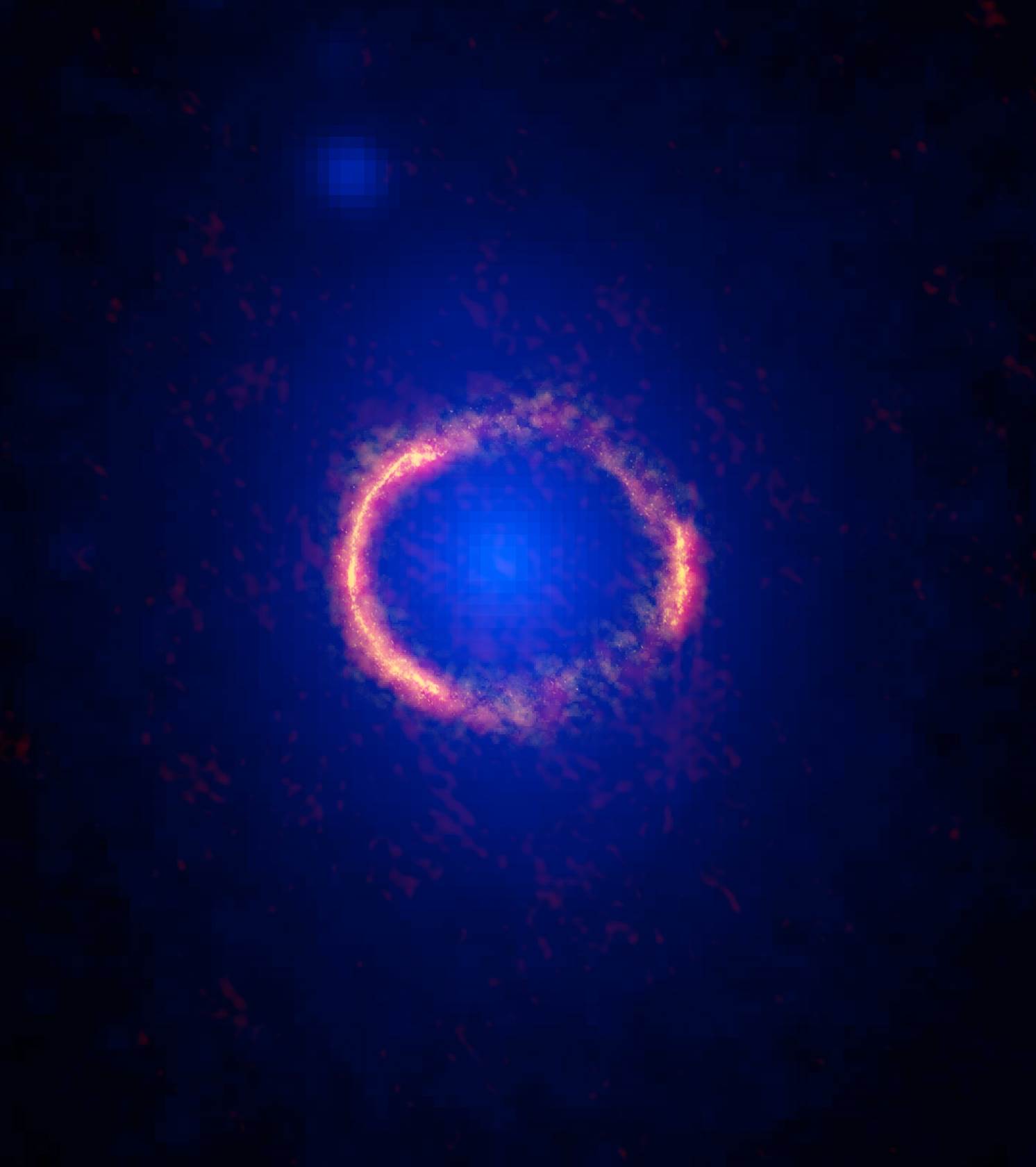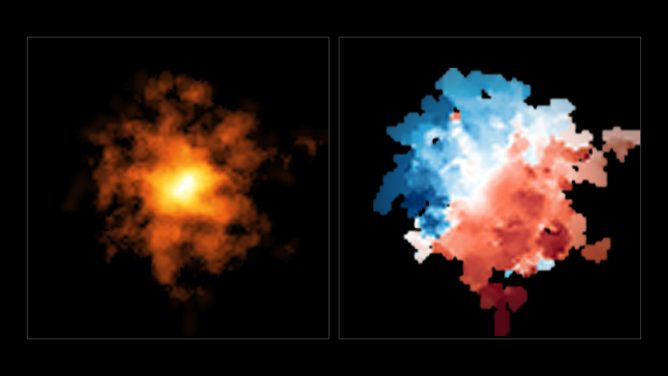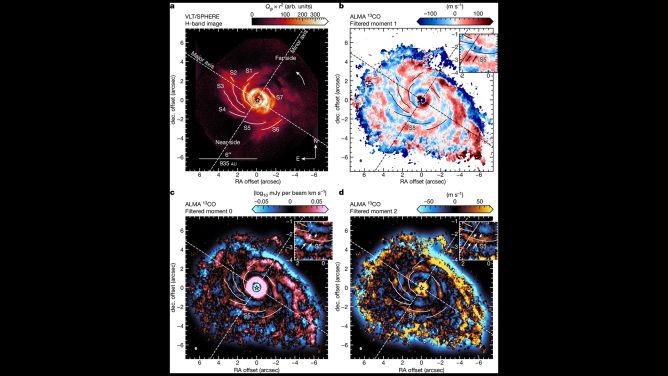Astronomers obtained unprecedentedly sharp images of a distant galaxy SDP.81 and an asteroid Juno with the Atacama Large Millimeter/submillimeter Array (ALMA). These images were taken in October 2014 as part of ALMA’s Long Baseline Campaign, an essential program to test and verify the telescope’s highest resolving power, achieved when the antennas are at their greatest separation: up to 15 kilometers apart. The images prove that ALMA is a very powerful tool for studying various targets, including nearby objects in our solar system and distant galaxies billions of light-years away.
“It takes a combination of ALMA’s high resolution and high sensitivity to unlock these otherwise hidden details of the Universe,” said ALMA Director Pierre Cox.
SDP.81: a lensed galaxy
Gravitational lensing occurs when a massive galaxy or cluster of galaxies bends the light emitted from a more distant galaxy, forming a highly magnified, though much distorted image, as predicted by Albert Einstein in his theory of general relativity. In this particular case, the galaxy known as SDP.81 and an intervening galaxy line up so perfectly that the light from the more distant one forms a nearly complete circle as seen from Earth.
Discovered by the Herschel Space Observatory, SDP.81 is an active star-forming galaxy nearly 11.7 billion light-years away, seen at a time when the Universe was only 15 percent of its current age. It is being lensed by a massive foreground galaxy that is a comparatively nearby 3.5 billion light-years away.
The highest resolution image of SDP.81 was made by observing the relatively bright light emitted by cosmic dust in the distant galaxy. This striking image reveals well-defined arcs in a pattern that hints at a more complete, nearly contiguous ring structure. Other slightly lower-resolution images, made by observing the faint molecular signatures of carbon monoxide and water, help complete the picture and provide important details about this distant galaxy.
Though this intriguing interplay of gravity and light in SDP.81 has been studied previously by other observatories, including radio observations with the Submillimeter Array and the Plateau de Bure Interferometer, and visible light observations with the Hubble Space Telescope, none has captured the remarkable details of the ring structure revealed by ALMA.
For these observations, ALMA achieved an astounding maximum resolution of 23 milliarcseconds, which is about the same as seeing the rim of a basketball hoop atop the Eiffel Tower from the observing deck of the Empire State Building.
Figure 1.ALMA/Hubble composite image of the gravitationally lensed galaxy SDP.81. The bright orange central region of the ring (ALMA’s highest resolution observation ever) reveals the glowing dust in this distant galaxy. The surrounding lower-resolution portions of the ring trace the millimeter wavelength light emitted by carbon dioxide and water molecules. The diffuse blue elements are from the intervening lensing galaxy, as seen with the Hubble Space Telescope.
Credit: ALMA (NRAO/ESO/NAOJ); B. Saxton NRAO/AUI/NSF; NASA/ESA Hubble
Download the ALMA image(JPEG)
Credit: ALMA(ESO/NAOJ/NRAO); B. Saxton NRAO/AUI/NSF
“The quality of the image is just astonishing, clearly showing the details of the Einstein ring.” said Daisuke Iono, an associate professor at the National Astronomical Observatory of Japan (NAOJ). “We can now study the details of how the foreground galaxy magnifies the background galaxy, and the details of the raw molecular material and star formation in the early universe. This is undoubtedly a big step forward in understanding the process of galaxy formation in the early universe.”
Juno: one of the largest asteroids
ALMA observed Juno for four hours on 19 October 2014 when the asteroid was approximately 300 million kilometers from Earth. The complete ALMA observation, which includes 10 separate images, documents about 60 percent of one rotation of the asteroid.
“In contrast to optical telescopes, which capture the reflected light from the Sun, the new ALMA images show the actual millimeter-wavelength light emitted by the asteroid,” said Todd Hunter, an astronomer with the National Radio Astronomy Observatory (NRAO). “By using ALMA to image the thermal glow from asteroids like Juno and other bodies in our solar system, astronomers will be able to study their shape, composition, and surface properties.”
Figure 2.Animation of the asteroid Juno as imaged by ALMA. Images were taken when Juno was approximately 295 million kilometers from Earth.
Credit: ALMA(ESO/NAOJ/NRAO)
Figure 3.Series of images of the asteroid Juno taken with ALMA.
Credit: ALMA(ESO/NAOJ/NRAO)
For this observation, ALMA achieved a resolution of 40 milliarcseconds, meaning that each “pixel” in the images is about 60 kilometers across, covering approximately one-fourth of the surface of Juno. This resolution is a vast improvement over earlier observations made at similar wavelengths and is enough to clearly resolve the shape of the asteroid and potentially tease out prominent surface features.
“This new observation clearly demonstrates that ALMA will be a very powerful tool for studying asteroids,” said NRAO astronomer Arielle Moullet. “At its highest resolution, ALMA is powerful enough to resolve the surface of many asteroids.” Earlier models of Juno developed by studying its reflected light indicate that it has an oblong, or potato-like, shape with possibly minor indentations on its surface. The ALMA images seem to support this model.
SDP.81 and Juno were the targets selected for study during the ALMA Long Baseline Campaign. The others include the protoplanetary disk HL Tau , the star Mira, and the quasar 3C138. The overall outcome of the ALMA Long Baseline Campaign was accepted for publication in the Astrophysical Journal Letters. The results shown here were accepted as ALMA Partnership et al. “ALMA Long Baseline Observations of the Strongly Lensed Submillimeter Galaxy HATLAS J090311.6+003906 at z=3.042” and ALMA Parnetship et al. “ALMA Observations of Asteroid 3 Juno at 60 Kilometer Resolution” in the Astrophysical Journal Letters.
ALMA
ALMA construction and operations are led by ESO on behalf of its Member States; by the National Radio Astronomy Observatory (NRAO), managed by Associated Universities, Inc. (AUI), on behalf of North America; and by the National Astronomical Observatory of Japan (NAOJ) on behalf of East Asia. The Joint ALMA Observatory (JAO) provides the unified leadership and management of the construction, commissioning and operation of ALMA.













